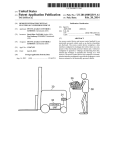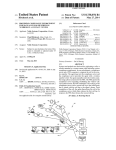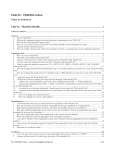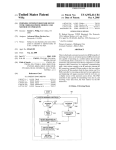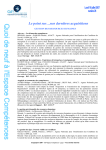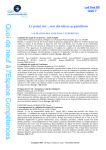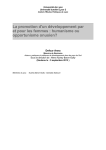Download Downloadable training content for contact center agents
Transcript
USOO8834175B1 (12) United States Patent (10) Patent N0.: Daddi et al. (54) (45) Date of Patent: DOWNLOADABLE TRAINING CONTENT FOR CONTACT CENTER AGENTS . 6,459,787 B2 6,628,777 B1 . (71) Apphcant: Noble Systems Corporation, Atlanta, Inventors: Rajesh S. Daddi, Atlanta, GA (US); Patrick McGuire McDaniel, Atlanta, . 10/2002 McIllwaine et a1. 9/2003 McIllwaine et al. 6,775,377 B2 8/2004 McIllwaine et al. 5/2006 7,174,010 B2 7,660,407 B2 2/2007 McIlwaine et al. 2/2010 Fama 8,108,237 B2 1/2012 BOUIne et ?l~ 2’} , GAGE), Karl H“ KOSter’ sandy Sep. 16, 2014 7,043,193 B1 7,158,628 B2 GA (Us) (72) US 8,834,175 B1 Vashi et a1. 1/2007 McConnell et at Iéyerly ettatlli , ourne e 2003/0044761 A1 * Spnngs, GA (U S) . 3/2003 Houlihan et al. ........... .. 434/350 (C ont1nued) (73) Assignee: Noble Systems Corporation, Atlanta, GA (U S) ( >x< ) Notice: OTHER PUBLICATIONS Subject to any disclaimer, the term Ofthis patent is extended or adjusted under 35 U.S.C. 154(b) by 0 days. Noble Systems Corporation, ShiftTrack Plus User Manual 5.6, Mar. 2012, 1350 PageS,Atl?Ilta, GA . (Cont1nued) (21) App1.No.: 13/744,895 (22) Filed: Jan. 18, 2013 Primary Exammer * Bruk Gebremlchael Related US. Application Data (57) ABSTRACT (63) Continuation-in-part of application No. 13/624,023, ?led on Sep. 21, 2012, noW Pat. No. 8,535,059, and a (51) (52) (58) A trainng 1391141 faFiliIaIeé an_agent’s management of train continuation-in-part of application No. 13/683,145, 111% courses; 1110111d1ng reVIewmg a tralnlng goal, 1ndlcatlng ?led on Nov. 21, 2012. training courses available for the agent to download, down Int- ClG09B 7/00 G09B 5/00 U-s- Cl- loading a speci?ed training course to the agent, and receiving uploaded test results associated With a previously down loaded training course. The training portal may cooperate With an e-learning system for identifying downloadable courses, and may cooperate With a content delivery system for (2006-01) (2006-01) CPC ...................................... .. G09B 5/00 (2013.01) USPC ......... .... ...... ... ...... .. 434/323; 434/322; 434/350 receiving the Speci?ed course Which is to he downloaded to the agent At a Suhsequeht time, after the agent has interaeted Fleld 0f ClaSSI?catlon seardl With a testing portion of the downloadable course, the agent CPC ....................................................... .. G09B 5/00 USPC .... .t ........................ .. 434/219, 322, 323, 365 may upload the test results t0 the portaL The training portal may be con?gured to receive test results uploaded Within a see apphcanon ?le for complete searCh hlsmry' certain time period. Once the training portal receives the test References Cited results, 1t prowdes the test results to the content dehvery (56) source. The content delivery source may then update the e-learning system. U.S. PATENT DOCUMENTS 6,301,573 B1 6,324,282 B1 10/2001 McIlwaine et al. 11/2001 McIllwaine et al. 15 Claims, 12 Drawing Sheets 400 Third-Party Content Source Content Delivery Syster112_2Q E-Learning 441 442 X System Local Content Library 520 Administrator Access US 8,834,175 B1 Page 2 (56) References Cited US, PATENT DOCUMENTS 2003/0129574 A1* 7/2003 2004/0165717 A1 8/2004 Mellwaine et 31, Ferriol et a1. ............... .. 434/362 2007/0198325 A1 55/2007 Lyerly 2007/0220145 A1* 9/2007 2008/0057482 A1* 3/2008 Snyder et a1. Kozakura et al. ........... .. 709/225 434/350 2008/0241812 A1 * 10/2008 Ashmore et al. ............ .. 434/365 2009/0181356 A1* 7/2009 Dasgupta ~~~~~~~~~~~~~~~~~~~~ ~- 434/362 2010/0035220 A1* 2/2010 HerZ et a1. .................. .. 434/236 2004/0202308 A1 10/2004 Baggenstoss 2011/0125499 141* 5/2011 GrlggsetaL 2004/0202309 A1 2005/0175971 A1 10/2004 Baggenstoss et a1. 8/2005 Mellwaine et al‘ 2012/0088217 A1 2012/0231441 A1* 4/2012 Freeman ~~~~~~~~~~~~~~~~~~~~~ ~- 434/350 9/2012 Parthasarathy et a1. ..... .. 434/362 2006/0072739 A1 4/2006 Baggenstoss et a1. 2006/0105315 A1* 5/2006 Shaver ........................ .. 434/362 2006/0188860 A1* 2006/0256953 A1 2007/0127689 A1 2007/0195944 A1 8/2006 11/2006 Mornson .................... .. 434/322 Pulaski et a1. 6/2007 Mellwaine et al‘ 8/2007 Korenblit et a1. 2007/0195945 A1 8/2007 2007/0198322 A1 8/2007 Bourne et a1. Korenblit OTHER PUBLICATIONS - - Noble Systems C0rp0rat10n, NobleWFM 2010.1.0 User Gulde, Mar. 28, 2011,324Page81At1anta, GA ' ' * c1ted by examlner US. Patent Sep. 16, 2014 Sheet 1 0112 US 8,834,175 B1 Local Network 16 Inter m ED 1 6a SDtaorae 170n: ]168 FIG. 1 US. Patent E5wmo;O a Sep. 16, 2014 Sheet 2 0f 12 EmEm? US 8,834,175 B1 US. Patent anwon Sep. 16, 2014 Sheet 3 0f 12 US 8,834,175 B1 US. Patent Sep. 16, 2014 Sheet 6 0f 12 US 8,834,175 B1 .9 mm u_ _ o\mn_b.mgWkQs\a~w<km 30>E8822552m“3m% 3%QQbEw“mhmBSaoiEcséhK .86mo\|J ownk x _\ odm“waeRQmkb US. Patent Sep. 16, 2014 Sheet 8 0f 12 Training Course Download 602 Agent Accesses Training Menu l Agent Requests Training Course To Be Downloaded l Agent Selects Training Course [8 [ES oA l Retrieve Training Course from Appropriate Source l Download Training Course to Mobile Device l [w Record in Agent's Profile That Course is Downloaded [3 l Set Response Time Period oA [on l Inform Agent of Response Time Period Fig. 6 US 8,834,175 B1 US. Patent Sep. 16, 2014 Sheet 9 or 12 Training Course Upload 702 \ 74 & Agent Access Training Menu l Agent Selects Upload Results of Training Course 76 & + Receive Training Course Results from Mobile Device 708\ + Validate Results 7Q Confirm Receipt to Agent 712 \ Update Agent’s Profile 7% Transmit Test Results to Appropriate System(s) Done FIG. 7 US 8,834,175 B1 US. Patent E o ONN mm? Sep. 16, 2014 Sheet 11 0f 12 US 8,834,175 B1 US 8,834,175 B1 1 2 DOWNLOADABLE TRAINING CONTENT FOR CONTACT CENTER AGENTS mobile devices to their maximum potential or download training content to other processing devices. Thus, contact centers have a need for an integrated, ef?cient, and ?exible architecture for managing training content that involves inter alia, mobile devices. It is with regard to this and other aspects that the present disclosure is presented. CROSS REFERENCE TO RELATED APPLICATIONS This application os a continuation of US. patent applica BRIEF SUMMARY tion Ser. No. 13/744,895, entitled Downloadable Training Content for Content Center Agents and ?led Jan. 18, 2013, which is a continuation-in-part of US. patent application Ser. Technologies are generally presented herein pertaining to a No. 13/624,023, entitled Learning Management System for learning management system providing downloadable train Call Center Agents, ?led on Sep. 21, 2012, and a continua ing courses. In certain embodiments, a training course may tion-in-part of US. patent application Ser. No. 13/683,145 entitled Training Portal for Call Center Agent Training, ?led comprise a training content portion and a testing portion. In addition, in certain embodiments, the downloadable training on Nov. 21, 2012, for which the contents of all are incorpo courses are downloaded to mobile devices used by call center rated by reference for all that they teach. agents. The call center agents can subsequently interact with the training content portion to learn the course content and BACKGROUND Contact centers often employ a number of agents for han dling inbound and outbound calls. The nature and purpose of the calls may vary greatly over a short time. For example, 20 the testing portion. In particular embodiments, a training portal provides a outbound calling campaigns may involve originating calls to collect debts, solicit donations for a non-pro?t organization, or offer new products for sale. Agents assigned to these cam point-of-contact for an agent to access to receive and manage their training, including such actions as reviewing training 25 paigns must be trained with the appropriate debt collection practices, familiar with the non-pro?t organization for which donations are sought, or knowledgeable about the products being offered for sale. These same agents may also be involved in handling inbound calls, and may be trained to answer questions associated with various products, custom ers seeking service, etc. It is evident that these agents must be trained in a variety of areas including how to operate the call center computer work stations, interact with other customer information systems for updating customer records, research product features, or being familiar with guidelines and policies associated with a telemarketing campaign. Additionally, it is not uncommon for employee turnover in call centers to be relatively high, requiring continual training of new agents. Agent training is important since training increases their effectiveness. Failure interact with the testing portion to demonstrate their knowl edge of the course content. In particular instances, the agents can subsequently upload the test results after interacting with courses the agent has taken, reviewing training courses avail able to the agent to take, and/or downloading a training course. The agent can also use the training portal to upload test results. In particular instances, the portal may provide the test results to a component in an e-leaming system so that the 30 test results may be processed and appropriate updates may be recorded in the agent’s training pro?le. 35 In one embodiment, the training portal is a web server con?gured to provide various web pages to the user, and to provide indications of training courses that can be down loaded to a mobile processing device, or other form of pro cessing device, used by the agent. After downloading a train ing course and logging-off from the portal, the agent can then 40 subsequently interact with the training course, including the testing portion. The mobile device retains the testing results, and after the agent subsequently logs-in to the portal, the testing results are uploaded to the portal. to train an agent can result in poor customer service, loss of In one embodiment, the training course is con?gured to revenue, and other adverse impacts. Thus, an ef?cient and effective infrastructure for training contact center agents is necessary. prevent sub sequent unauthorized interaction with the training course including preventing the user from subsequently 45 Training systems may provide computer-based learning that allows each agent to receive training in a manner that suits the agent’s schedule. Some training systems are designed to be locally executed on the agent’s workstation computer while other training systems can be hosted on a server and can provide training content streamed to the agent via network interconnection. 50 The growing popularity of tablet computers, which is one form of a growing category of mobile processing devices, allows agents to obtain training whenever it is convenient to their schedule. This may require that the training content be downloaded into their mobile device well in advance of when the training session actually begins. In other applications, an agent may desire to interact with training content using their home computer during their off-hours. In either instance, the agent may interact with the training content after it is loaded into their computer. However, such training systems are not integrated into the embodiments, the architecture allows training to be provided to agents in a ?exible and adaptable manner, and allows 55 call handling systems, and the training infrastructure. Further, such training systems are not con?gured to accommodate various levels of integration with operation of call center components. The subject matter disclosed herein may be implemented as a computer-controlled apparatus, a computer process, a computing system, or as an article of manufacture such as a 60 computer readable storage medium. These and various other features will be apparent from the following Detailed Description and the associated drawings. This Summary is provided to exemplify concepts in a high level form that are further described below in the Detailed contact center infrastructure and may cause additional admin istrative burdens to coordinate training between the agent, downloading the training course from the mobile device to another unauthorized device or for storage in another storage medium. In certain embodiments, the user may have a time limit during which they must interact with the training course. Depending on the embodiment, the architecture may use various data structures that allow appropriate information to be maintained about the training status for the agent and how courses are to be provided to agent. Thus, in particular 65 Description. This Summary is not intended to identify key or essential features of the claimed subject matter, nor is it intended that this Summary be used to limit the scope of the US 8,834,175 B1 3 4 claimed subject matter. Furthermore, the claimed subject an analog plain old telephone service (“POTS”) line 11611. matter is not limited to implementations that address any or The calls may be routed by the PSTN 115 and may comprise various types of facilities 116d, including, but not limited to: all disadvantages noted in any part of this disclosure. Ti trunks, SONET based ?ber optic networks, ATM networks, etc.Various types of routers, switches, bridges, gateways, and other types of equipment may be involved in the processing of BRIEF DESCRIPTION OF THE DRAWINGS a call. Reference will now be made to the accompanying draw ings, which are not necessarily drawn to scale, and wherein: FIG. 1 shows one embodiment of a contact center archi tecture for which the various technologies disclosed herein can be applied; 10 integrated services digital network (“ISDN”) interface 116!) FIG. 2 illustrates one embodiment of an e-learning man or other types of interfaces that are well known to those skilled in the art. The MSP 112 may also route calls as agement system comprising an e-learning module; FIG. 3 illustrates one embodiment of the e-learning mod ule; FIG. 4 illustrates one embodiment of an architecture com prising a training portal for facilitating downloadable training content from the e-learning management system; FIGS. 5A-5C illustrate various graphical user interfaces for facilitating downloadable training content; 20 (“TDM”) technology. agent downloading training content; Voice calls may also originate from a calling party employ ing a so-called “IP phone,” “VoIP phone,” or “soft phone” FIG. 7 illustrates one embodiment of a process ?ow for an agent uploading test results; 25 tablet, which interfaces with a headphone/microphone com bination, also referred to as a “headset” 106.An IP phone may FIG. 9 illustrates another embodiment of a messaging ?ow associated with an agent downloading training content; and FIG. 10 illustrates one embodiment of a processing device 30 such as a cable company providing Internet access services over a coaxial cable facility 116e. Those skilled in the art will Various embodiments for practicing the technologies dis 35 40 embodiments applying the teachings and concepts disclosed herein. Like numbers in the drawings refer to like elements originating from any type of device, such as a soft phone 11011, conventional telephone, 110b, a mobile device 1100, or other device known in the art. The term “call” as used herein may mean an active instance of two-way communication, an throughout. Exemplary Call Center Architecture FIG. 1 shows one embodiment of a contact center archi recognize that a variety of protocols and facilities may be used to convey voice calls. The term “telephone call” as used herein is generally syn onymous with a “voice call” unless indicated otherwise. Fur ther, the term “telephone call” may encompass a voice call that this disclosure will satisfy applicable legal requirements and should not be construed as limiting or precluding other use a digital voice control protocol and may process pack etized voice data according to various Internet based voice protocols, such as session initiated protocol (“SIP”). The call may be conveyed by other types of Internet providers 123a, DETAILED DESCRIPTION closed herein are described more fully hereinafter with refer ence to the accompanying drawings, in which some, but not all embodiments of the technologies disclosed are shown. Indeed, the embodiments disclosed herein are provided so 11011. In one embodiment, this device may comprise a com puting device 105, such as a laptop, desktop, or computing associated with an agent downloading training content; used to practice the technologies disclosed herein. packetized voice, referred to herein as voice-over-IP (“VoIP”) to an Internet provider 123a using Internet-based protocols. For convenience, unless indicated otherwise, the term “trunk” refers to any type of facility 1160, 116d, or 116e providing voice calls to, or from, the contact center, regardless of the type of protocol or technology used. Speci?cally, a “trunk” as referred to herein is not limited to time-division multiplexing FIG. 6 illustrates one embodiment of a process ?ow for an FIG. 8 illustrates one embodiment of a messaging ?ow Inbound voice calls may also originate from a mobile device 1100, such as a smart phone or tablet, which wirelessly communicates with a mobile service provider (“MSP”) 112. The voice calls may be routed to the PSTN 115 using an attempt to establish two-way communication, or a portion of 45 the two-way communication. For example, a user at a con Although many aspects of contact center operation are dis closed in the context of voice calls, the contact center may process other forms of communication such as facsimiles, emails, text messages, video calls, chat messages, and other forms. Since the contact center may handle calls originating 50 ventional telephone 1101) can dial a telephone call in an attempt to establish two-way communication, and a call can be said to exist even prior to establishment of a two-way connection. In another example, a call may be put on hold, and a portion of the call may also be referred to as a “call leg” from a calling party, or initiated to a called party, the term 55 tecture 100 illustrating the various technologies disclosed herein. The contact center shown in FIG. 1 may process voice calls that are inbound-only, outbound-only, or a combination of both (sometimes referred to as a “blended” contact center). existing between the caller and certain equipment. A call may comprise a number of concatenated call legs, as known to those skilled in the art. In certain contexts, which will be made “party” without any further quali?cation refers to a person associated with an instance of communication processed by the contact center, such as a call, where the call is either received from or placed to the party. The term “caller,” if used, may generally refer to a party calling the contact center, but in many cases this usage is exemplary. Thus, use of the term “caller” is not intended to necessarily limit the concepts herein to only inbound calls unless the context dictates such. Inbound voice calls may originate from calling parties using a variety of phone types. A calling party may originate explicit, the call may encompass communications other than voice, e.g., text messages, video chat, facsimile, etc. Inbound calls from callers to the contact center may be received at an automatic call distributor (“ACD”) 130. The ACD 130 may be a specialized switch for receiving and routing inbound calls under various conditions. The ACD 130 may be embodied as a dedicated form of equipment readily available from various manufacturers, or the ACD 130 can be a so-called “soft switch” comprising a suitable programming module executed by a processing device to perform the nec essary functions. The ACD 130 may route an incoming call 65 over contact center facilities 165 to an available agent. The a call from a conventional analog telephone 1101) connected facilities 165 may be any suitable technology for conveying to a public switched telephone network (“PSTN”) 115 using the call, including, but not limited to, a local area network US 8,834,175 B1 5 6 (“LAN”), wide area network (“WAN”), ISDN, or conven tional TDM circuits. The facilities 165 may be the same or different from the facilities used to transport the call to the ACD 130. Calls may be routed over facilities 165 to an agent for The second type of signaling information that may be provided with an inbound call is the calling telephone num ber, often referred to as automatic number identi?cation or “ANI.” In one con?guration, the ACD 130 and/ or CTI server 145 may use the ANI of an incoming call to retrieve caller information from a data store 175 and provide the data to the servicing. That is, the party may speak with an agent for receiving, for example, customer service. The physical area at which the agent sits is often referred to as an agent “position” and these positions are often grouped into clusters that are managed by a supervisor, who may monitor calls and the agents’ productivity. An agent usually uses a computing agent’s workstation computer along with routing the call to the agent’ s workstation phone. For example, the ANI can also be used to ascertain a party’s status (e.g., a “Gold Level” customer warranting premium service) to facilitate the ACD 130 routing the call to a select group of agents. The data store 175 can be a database storing records of caller information. The data store 175 can be integrated with the CTI server 145, the ACD 130, or segregated as a standalone database. Thus, the call and associated call data retrieved from the data store 175 are presented at the agent’s headset 16119 and their com puter 16019. In other embodiments, data may be stored in the device, such as a computer 16011-1600 and a voice device 16111-1610. The combination of computer and voice device may be referred to as a “workstation.” Thus, the workstation collectively has a data capability and a voice capability, though separate devices may be used. In some instances, “workstation” may be used in reference to speci?cally either the data or voice capability at the agent’s position, as appro priate to the context. For example, “routing the call to the agent’s workstation” means routing a call to one of the voice data store 175 by the agent, ACD, or other entity. 20 devices 16111-1610 at the agent’s position. Similarly, “routing The ACD 130 may place a call in a queue if there are no suitable agents available, or it may route the call to an inter the call to the agent” means routing a call to the appropriate active voice response server (“IVR”) 135 to play voice prompts. These prompts may be in a menu type structure and equipment at an agent’s position. the IVR 135 may collect and analyze responses from the party The voice device used by an agent may be a soft phone device exempli?ed by a headset 161a connected to the com in the form of dual-tone multiple frequency (“DMTF”) tones 25 puter 16011. The soft phone may be virtual telephone imple mented in part by an application program executing in a computer. The phone may also comprise an Internet Protocol (“IP”) based headset 16119 or a conventional phone 1610. Use of the term “phone” is intended to encompass all these types of voice devices used by an agent, unless indicated otherwise. the purpose of the call to the CTI server 145, such as prompt ing the party to enter account information, or otherwise obtain information used to service the call. The IVR 135 may inter act with other components, such as the CTI server 145 or the 30 data store 175, in order to retrieve or provide information for processing the call. In other con?gurations, the IVR 135 may be used to only provide announcements. The interaction between the ACD 130, IVR 135, CTI An agent typically logs onto their workstation prior to handling calls. This allows the contact center to know which agents are available for handling calls. TheACD 130 may also maintain data of an agent’s skill level that is used to route a speci?c call to the agent, or group of agents having the same skill level. If a suitable agent is not available to handle a call, the ACD 130 may queue the call for the next available agent. and/or speech. The IVR 135 may be used to further identify 35 server 145, agent computers 16011-1600, as well as other components, may involve using a local area network (“LAN”) 170. Other communication con?gurations are pos sible, such as, but not limited to, using a wide area network, wireless network, router, bridge, direct point-to-point links, As can be expected, various algorithms may be employed to etc. the inbound call that the ACD 130 uses in processing the call. When an agent is interacting with a called or calling party, the agent may use their workstation computer 1601) to further interact with other enterprise computing systems, such as a The ?rst type of signaling information indicates the telephone customer relationship management (“CRM”) server 140. A process calls in an ef?cient manner. 40 Two types of signaling information may be provided with number dialed by the caller, and is frequently referred to as “DNIS,” derived from the Dialed Number Identi?cation Ser vice associated with this capability. A contact center may provide various services, such as sales, customer service, technical support, etc., each of which may be associated with a different telephone number (e.g., multiple toll free “800” numbers). The DNIS can be used by the ACD 130 to deter mine the purpose of the call, and potentially identify a group of agents having the appropriate skill level to handle the call. CRM server 140 may be used to integrate information from 45 servicing the call. A variety of applications may be provided by a CRM server 140. In addition to receiving inbound communications, includ ing voice calls, emails, and facsimiles, and the contact center 50 may also originate communications to a called party, referred to herein as “outbound” communications. In some embodi ments, a contact center may employ a dialer 150, such as a predictive dialer, to originate outbound calls on behalf of an The ACD 130 may prioritize and route calls to an agent based on the required skill level. Skills-based routing may be a rule-based set of instructions that the ACD 130 uses to handle various enterprise business systems to facilitate the agent agent at a rate designed to meet various criteria. Similar to the 55 other components within the contact center architecture 100, calls. Skills-based routing may be implemented by the ACD the dialer 150 may comprise one or more software modules 130, or by the ACD 130 interacting with a computer-tele executing on processing device hardware platform. phone integrated (“CTI”) server 145. The dialer 150 is typically con?gured to dial a list of telephone numbers to initiate outbound calls, which can be The CTI server 145 may be incorporated in a contact center to control and/or coordinate other components of the contact center architecture 100. Speci?cally, the CTI server 145 may interact with the ACD 130 to coordinate call processing. Thus, in some embodiments, the CTI server 145 may control the routing of calls from the ACD 130 to the various agent 60 workstations and/or provide data to other components pro cessing the call. The CTI server 145 may also provide call reporting functionality based on data collected during calls. 65 accomplished in one embodiment by instructing the ACD 130 to originate calls. In some embodiments, the ACD 130 may include functionality for originating calls, and if so, this com ponent may be referred to as a private automatic branch exchange (“PBX” or “PABX”). In other embodiments (not shown), the dialer 150 may directly interface with voice trunks using facilities 1160, 116d to the PSTN 115 for origi nating calls. After the calls are originated, a transfer operation US 8,834,175 B1 7 8 by the ACD 130 or the dialer 150 may connect the call with an agent, orplace the call in a queue for an available agent. In the latter case, announcements or music may be provided to the party. In various embodiments, the dialer 150 may make use of one or more algorithms to determine how and when to dial usually prompted to enter a “pause code.” The pause code indicates the nature of the break, such as a lunch break, bathroom break, etc. Typically, if the agent is in the connected mode and requests to be placed into the pause mode, the call is allowed to complete. That is, an agent requesting to be placed into the pause mode does not typically interrupt a current call. The ready mode, connect mode, after-call-work mode, and the pause mode all occur when the agent is lo gged in to the ACD. When the agent logs off or logs out, then none a list of numbers so as to minimize the likelihood of a called party being placed in a queue while maintaining target agent utilization. Another component that may be employed in a contact center is a workforce management (“WFM”) 155. This com of the above modes can exist. Thus, the above modes presume ponent maintains information to generate agent’s schedules to effectively handle inbound/outbound calls. The WFM 155 that the agent is logged-in. An agent that is not logged-in and is presently working their shift would be considered “off-the may maintain historical call volume information for call cam clock.” Although the above components may be variously referred paigns and forecast expected call volume to predict the num ber of agents needed to handle the call volume at a de?ned service level. The WFM 155 can then apply information about available agents to then generate a work roster of to as “servers,” each may be also referred to as a “processing agents. In other words, the WFM 155 schedules agents for their work shifts according to the anticipated needs of the call external database. Use of the word “server” herein does not require the component to interact in a client-server arrange campaigns. device,” “unit,” “component” or “system” and may incorpo rate therein a local data store or database, or interface with an 20 may be located remotely from (or co-located with) other training-related functions. The e-learning system 156 may coordinate other components to provide training to agents. In some embodiments, the e-learning system 156 could be a distinct system that cooperates with the WFM 155, or the ment using web-based protocols with other components, although that may be the case. Further, the above components In various embodiments, the contact center architecture 100 may include an e-learning system 156 to perform various components. Furthermore, one or more of the components 25 may be implemented on a single processing device to perform the functions described herein. For example, in various e-learning system could comprise a module incorporated in embodiments, one or more functionalities of the ACD 130, the IVR server 135, the CRM server 140, the CTI server 145, the WFM 155. Various embodiments are possible and FIG. 1 only illustrates one embodiment. Further details on the and/or the dialer 150 may be combined into single hardware platform executing one of more software modules. The train e-learning architecture will be discussed below. 30 ing portal 158 may be integrated with the e-learning system 35 bined with the WFM 155. In addition, the contact center architecture 100 may be provided as a hosted solution, where the call processing func tionality is provided as a communication service (a so-called In various embodiments, the contact center architecture 156, and either or both may be integrated or otherwise com 100 may include a training portal 158. The training portal 158 may be, in one embodiment, a web server that allows users (such as agents or call center administrators) to manage train ing. The training portal 158 may also have connection to Internet related facilities either directly, or via other call cen “communication as a service” or “CaaS”) to a contact center ter components. The training portal 158 may interact with the operator. Thus, there is no requirement that the components e-learning system, and may also function as a “front-end” to identi?ed above must be actually located or controlled by a contact center operator. Speci?cally, the learning manage allow these users to easily interact with the e-learning system for managing training. The training portal 158 may also coor dinate with other providers of downloadable content, and 40 may also receive uploads from a user comprising test results associated with previously downloaded content. The training portal 158 may also coordinate providing uploaded content back to the content provider and/or the e-learning system as 45 ment system and/or the training portal disclosed herein can be provided on a hosted basis in a variety of con?gurations. In addition, the agent positions can be co-located in a single physical contact center or in multiple physical contact cen ters. The agents can be remotely located from the other com ponents of the contact center, and may also be remotely required. In various embodiments, the e-learning system and/ located from each other, sometimes referred to as a “virtual or training portal 158 may be offered in a hosted environment or as a service offered by a third party provider. An agent may be considered as being in one of four differ ent modes when working. Thus, these modes can be said to contact center.” A virtual contact center may describe a sce nario where agents work at home, using their own computers and telephones as workstations. In some con?gurations, a 50 describe the agent during a shift. During a shift, the agent is “logged-in” to the ACD and/or the WFM and is typically available and ready for receiving calls or other forms of functions are provided as a service in a hosted cloud comput communication, if any are present. This can be described as the “ready” mode. If the agent is connected and speaking with 55 a caller, then the agent can be described as being in the “connected” mode. Once the call terminates, the agent may have additional work to perform such as, for instance, record ing notes on the caller’s record. This can be described as “after-call-wor ” mode. Once the agent has indicated a dis 60 The speci?c components that are present in a contact center may vary, and for this reason a generic term of a “call han dling system” will be used. Reference to this term should be understood to also encompass components that handle forms agent can be removed from the ready mode and placed into a agent may request to be placed into the pause mode. If the agent requests to be placed into the pause mode, they are ing environment and the agents positions are in their indi vidual residences. Those skilled in art will recognize FIG. 1 represents one possible con?guration of a contact center architecture 100, and that variations are possible with respect to the protocols, con?guration, facilities, technologies, and equipment used. position, the agent returns to the ready mode. In addition, the “pause” mode. In this mode, the ACD typically suspends offering calls to the agent. The agent may be placed into the pause mode by another entity (e.g., the supervisor) or the single physical location of the contact center may not be readily identi?able. This may occur when the call processing of contacts other than just telephone calls, such as emails, text, web chats, etc. 65 Overview of the E-Learning System A brief overview of the e-learning system is appropriate to understand the interaction of the training portal with respect US 8,834,175 B1 9 10 to the e-learning system. A complete description of the e-learning system is contained in the US. patent application Ser. No. 13/624,023, entitled Learning Management System for Call Center Agents, ?led on Sep. 21, 2012, (henceforth post-training reporting of training sessions. Not all modules are required in all embodiments. In FIG. 3, the e-learning module 210 includes two agent selection modules, the automatic agent selection module 381 and the manual agent selection module 384. These modules referred to as the “the LMS Patent Application”), the contents of which are incorporated by reference. can be used to select agents that are to be trained. The auto matic agent selection module 381 may have one or more FIG. 2 discloses one embodiment of an architecture 200 associated with the e-learning system. It should be appreci interfaces 391 to other call center components and the inter ated that not all components illustrated in this architecture may be present in all embodiments, or present as illustrated. face 391 receives metrics associated with agent performance. The rules component 382 indicates how these metrics may be The e-learning system 156 is the platform that includes the used to identify the agents requiring additional training. e-learning module 210, which in one embodiment is the soft ware which performs the associated functions. The e-learning module may, in turn, include other modules which perform Alternatively, or in addition, the manual agent selection mod ule 384 may provide a GUI 392 using various agent selection tools 383 for allowing an administrator to manually select an agent. In some embodiments, the interface 392 may be anAPI various functions associated with delivering (e. g., streaming) training courses to an agent 271. The e-learning module 210 to the training portal 158, or the manual agent selection mod may interact over an interface 253 with a content delivery ule could comprise the training portal itself. The agent selec system (“CDS”) 220 which has a corresponding e-learning interface module 227. In one embodiment, the CDS provides the streaming content, stored in a training content database 225, to the agent 271 using an interface 261. In other embodi ments, the CDS 220 may also fumish the training courses in tion modules may store and/ or access agent related data in the 20 Once agents are selected, a work?ow manager 380 may a downloadable format. The e-learning module 210 may cooperate with a WFM 155 using an interface 257 for coordinating when an agent is to be trained. In some embodiments, the e-learning module 210 may rely on the WFM to schedule training courses. The 25 30 information. The WFM 155 may also have an interface 250 the CDS 220, and the work?ow manager may invoke the training. The WFM may also have an interface 249 to the 35 ing training. 40 communication facility. Finally, the administration tools 390 can be used by an administrator via a GUI 393 to set various parameters of the 45 e-learning system, and also to access the training manage ment module 387 for storing and managing aspects of the training process. This can be used for setting parameters, limits, or managing other operational aspects. Additional 50 tioned LMS Patent Application. Training Portal Architectural Overview The aforementioned e-learning system may provide lim ited user interfaces for interacting with the e-learning system. However, for some embodiments, the e-learning system may not provide the desired graphical user interfaces for allowing agents to manage their training, but another component may provide the graphical user interfaces. That is, in some details for this and other aspects are found in the aforemen ing module may also have an interface 254 to the CHS 230 for receiving information as to how busy an agent presently is. The e-learning module may provide training to agents who currently are not busy and an interface 256 may be used by the 55 The e-learning architecture 200 is able to deliver training courses to an agent in different ways, including streaming courses to their workstation 160. The e-learning architecture can provide training to agents in various forms, such as ?xed time, ?ex-time, and with further categorization related to the embodiments, the e-learning system may be integrated with other call center components, such as the WFM, and this 60 integrated system may be designed for administrator access to manage agent training, as opposed to allowing the agent to access the system. Instead, in these embodiments, a training portal 158 may be utilized to provide and manage the agent 65 ing various GUI forms to be de?ned and/or adapted for agent end-users, and provide a front-end interaction with the form of delivery are possible, such as on-demand or snippet training. Further description of these and other capabilities are found in the LMS Patent Application. Further details regarding the e-learning module 210 are shown in FIG. 3. The e-learning module in one embodiment may comprise a set of modules performing functions associ ated with the agent selection, registration, scheduling, and appropriate updates. This communication by the interface module 385 can be provided using a LAN, WAN, or other have an interface 255 to an agent skill level database 233 to agent in conjunction with this capability. These capabilities may require the interface module 385 to ponents, such as the CDS, the CHS, the WFM, agent work station, and/or the training portal to receive and provide the receiving agent performance metrics from other components, update the agent’ s skills The agent skill level database may be used by the CHS 230 in routing calls to the agent. The e-leam post-training reporting module 389 to update the agent train ing pro?le database 212. interface and inform the work?ow manager with other com The e-learning module may have an interface 251 for which can be used to identify which agents have poor perfor mance, and hence may require additional training. The e-learning module may also have an interface 252 for allow ing agents to be selected for training by an administrator. This could also be used by other components that interact with the e-learning system and/or users. The e-learning module may also have an interface 259 to an agent training pro?le database 212 which is updated as agents receive training. Once the agent’s skills are updated, the e-learning module may also gered based on various conditions according to how the train ing format was de?ned. Once the training session has com pleted, the work?ow manager is provided with the results by with the call handler system (“CHS”) 230 to coordinate when the agent is to be logged in for handling calls or paused for agent workstation 160 for informing the agent about upcom then invoke a registration module 386 to register the selected agents for the intended training course. Registration may involve ensuring that all prerequisites and other rules are met necessary for the agents to receive the training course mate rials. When completed, the work?ow manager 380 may invoke the scheduling module 388, if the training is of a ?xed-time format. The training content delivery may be trig WFM 155 may have an interface 258 to an agent work sched ule database 260 that maintains the agent’s work schedule agent training list 395. interaction. The training portal can act as a “front end,” allow e-learning system. Inparticular instances, these embodiments US 8,834,175 B1 11 12 allow customization of how the GUI is de?ned, and also regarding a computer product, but may also receive additional “off-loads” this front-end processing from the e-learning sys background information and access to the actual product user tem. management support functions may allow agents to review courses previously taken in the training program, whether the manuals to better understand the computer product. These user manuals could be stored in the local content library 520, and the agent may desire to download both the user manuals and the training course materials to study them. Similarly, other background subject matter may be available from a third-content source 410. For instance, otherbackground sub ject matter could comprise a number of third party informa tion sources available on various web sites. The training por tal could access the local content library via any number of courses were passed, what courses are available for a given facilities 443, as well as access a thirdparty content source via agent to take, which of the available courses are required to any number of facilities 445. The portal 158 may also access the e-leaming system 156 The training portal 158 can also provide various training management support functions that are useful and speci?c to an enterprise. For example, training management support functions may allow agents to de?ne and review a training program comprising a series of courses required in order to achieve a new skill or certi?cation level. Further, the training complete a particular skill certi?cation, when can the training courses be taken, etc. The training portal may also provide via facilities 442. The portal 158 may provide training content via the e-learning system 156 as opposed to via the CDS access to related content from other sources, but which con tent is not the actual training content administered by the e-leaming system. For example, an agent may access various engineering, technical, and user manuals that are made avail able for the agent as support documents, but which are sepa rate from the training courses provided by the CDS. For example, a training course may provide training on a product directly. In other words, in some embodiments, access to the CDS 220 is not provided directly to the portal 158, but only through the e-learning system 156. In other embodiments, the 20 access and how to access it. For example, in particular embodiments, an agent may which the agent supports, and the training portal may also provide access to related support documents and product manuals for the product as background information to the only be able to access training courses which the agent has been authorized to access by the e-learning system. Further, 25 agent. One embodiment of the architecture 400 utilizing the train ing portal is shown in FIG. 4. The portal 158 may be embod ied as a stand-alone web server, or in other embodiments, the portal may be integrated into platforms including other call 30 center components. The portal 158 serves as the main user interface for the agent and the administrator for managing agent training. The portal 158 is typically interfaced via facilities 444 to the Internet 123b, which in turn can be accessed by a mobile 35 device 425 operated by an agent using a variety of technolo gies 403. Thus, for purposes herein, reference to “interactions with the agent” or similar language means interactions with a processing device (such as a mobile device 425 or tablet computer) operated by the agent. The portal 158 could also be 40 accessed by the agent using a PC or other stationary comput ing device 427 that accesses the Internet via various facilities 407 known in the art. For purposes of illustration, and not 50 tent. The agent may then need to access a training course access the HR manual in addition to accessing training con and/or a test for becoming a supervisor. This may require the portal 158 to query the e-learning system to determine whether the agent is authorized to take the supervisor exam, over a facility 441, such as a LAN, WAN, or other form. The which may cover aspects indicated in the HR manual. The 55 60 ing system may obtain the training course from the CDS, or alternatively, may direct the portal to the CDS to download the content, and then provide the content to the agent. In various embodiments, the e-learning system 156 is con ?gured to process test results for a training course depending on whether the training course was downloaded to the agent In some instances, the portal 158 may access a local con tent library 520 to provide downloadable information to an agent. For example, an agent being trained on a particular subject matter may seek supplemental information that is located in the local content library 520. For instance, an agent may receive training courses from the CDS system 220 portal may query the e-leaming system to determine whether the content can be downloaded to the agent. If so, the e-learn types of content. For example, one third-party content source may provide information on regulatory training content about certain types of ?nancial instruments, while another third party content provider may provide information about ?nan cial products from a particular vendor. information about what courses the agent is allowed to take, de?ned training programs, what skills the agent is to be trained for, etc. The portal 158 may use this information to determine what training content the agent may download. In various embodiments, the training portal 158 may limit an agent’s access to some training materials, but not others. For example, an agent desiring to become a supervisor may be resource (“HR”) policies. Thus, the agent may access and download via the portal a copy of the company’s HR Policy Manual, which may be stored in the local content library 520. Further, the portal may be con?gured to allow any agent to portal 158 may also access downloadable training content from a third party content source 410. In various embodi ments, there may be a number of sources that provide various associated with the training course, the e-leaming system may record and update the agent’ s training pro?le in the agent training pro?le database 212. Thus, in some embodiments, all portal interactions for receiving training courses and upload ing training courses may be via the e-learning system, whereas in other embodiments, the portal may interact with the CDS directly. To properly interact with the agent, the portal may ?rst have to identify the agent, which can be accomplished by the agent logging into the portal using an identi?er and password. Then, the portal may access the e-learning system to retrieve 45 illustrative web pages will be discussed shortly. The portal 158 may access other call center components on the “back-end.” These may vary in different embodiments. For example, the portal 158 may access the CDS 220 for receiving downloadable training content. This may occur when an agent completes a training course and takes a test required to be knowledgeable of the company’s human limitation, FIG. 4 depicts the agent using a mobile device 425 and the administrator using a stationary device 427 to access the portal. Once the agent or administrator accesses the portal 158, various web pages can be served and presented. Various portal accesses the e-leaming system to learn which CDS to 65 using the training portal or streamed to the agent. Recall from the aforementioned patent application, the LMS Patent Appli cation that streaming training content may be provided by the CDS 220 to the workstation used by the agent in various embodiments. In particular instances, the training content



























